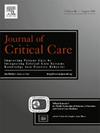重症监护室获得性乏力的发生与重症监护室入院时身体成分之间的关系:描述性研究。
IF 3.2
3区 医学
Q2 CRITICAL CARE MEDICINE
引用次数: 0
摘要
目的:评估重症监护病房(ICU)获得性虚弱(ICU-AW)患者和非获得性虚弱(ICU-AW)患者入院时身体成分的差异:这项单中心回顾性队列研究在日本筑波纪念医院的混合重症监护病房进行。我们纳入了入院前能独立行走、入院后接受康复治疗且存活至少 48 小时的患者。患者被分为重症监护病房辅助行走组和非重症监护病房辅助行走组,并对他们的特征、结果和身体成分进行了比较:在分析的 282 名患者中,有 28 人(9.9%)出现了 ICU-AW。ICU-AW 患者年龄较大(79 [72-86] vs. 70 [61-77],P 结论:ICU-AW 患者的预后较差:与非 ICU-AW 患者相比,ICU-AW 患者入院时的细胞营养状况较差,但骨骼肌质量相似。本文章由计算机程序翻译,如有差异,请以英文原文为准。
Association between the development of intensive care unit-acquired weakness and body composition at intensive care unit admission: A descriptive study
Purpose
To evaluate differences in body composition at intensive care unit (ICU) admission between patients with and without ICU-acquired weakness (ICU-AW).
Materials and methods
This single-center, retrospective cohort study was conducted at Tsukuba Memorial Hospital's mixed ICU in Japan. We included patients who could walk unassisted before admission, received rehabilitation post-admission, and survived for at least 48 h. Body composition was assessed using bioelectrical impedance analysis (BIA) at ICU admission. Patients were classified into ICU-AW and non-ICU-AW groups, and their characteristics, outcomes, and body compositions were compared.
Results
Of the 282 patients analyzed, 28 (9.9 %) developed ICU-AW. ICU-AW patients were older (79 [72–86] vs. 70 [61–77], P < 0.01) and had higher SOFA scores (8 [5–13][ vs. 3 [2–6], P < 0.01). BIA showed a higher extracellular water to total body water ratio (0.408 [0.391–0.414] vs. 0.388 [0.380–0.400], P < 0.01) and a lower phase angle (3.7 [3.3–4.9] vs. 4.9 [4.2–5.7], P < 0.01) in the ICU-AW group. Skeletal muscle mass was similar between groups (23.2 [18.9–26.0] vs. 24.8 [20.5–28.3], P = 0.07).
Conclusions
ICU-AW patients had poorer cellular nutritional status but similar skeletal muscle mass at ICU admission compared to non-ICU-AW patients.
求助全文
通过发布文献求助,成功后即可免费获取论文全文。
去求助
来源期刊

Journal of critical care
医学-危重病医学
CiteScore
8.60
自引率
2.70%
发文量
237
审稿时长
23 days
期刊介绍:
The Journal of Critical Care, the official publication of the World Federation of Societies of Intensive and Critical Care Medicine (WFSICCM), is a leading international, peer-reviewed journal providing original research, review articles, tutorials, and invited articles for physicians and allied health professionals involved in treating the critically ill. The Journal aims to improve patient care by furthering understanding of health systems research and its integration into clinical practice.
The Journal will include articles which discuss:
All aspects of health services research in critical care
System based practice in anesthesiology, perioperative and critical care medicine
The interface between anesthesiology, critical care medicine and pain
Integrating intraoperative management in preparation for postoperative critical care management and recovery
Optimizing patient management, i.e., exploring the interface between evidence-based principles or clinical insight into management and care of complex patients
The team approach in the OR and ICU
System-based research
Medical ethics
Technology in medicine
Seminars discussing current, state of the art, and sometimes controversial topics in anesthesiology, critical care medicine, and professional education
Residency Education.
 求助内容:
求助内容: 应助结果提醒方式:
应助结果提醒方式:


